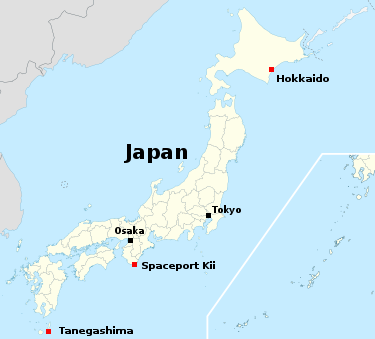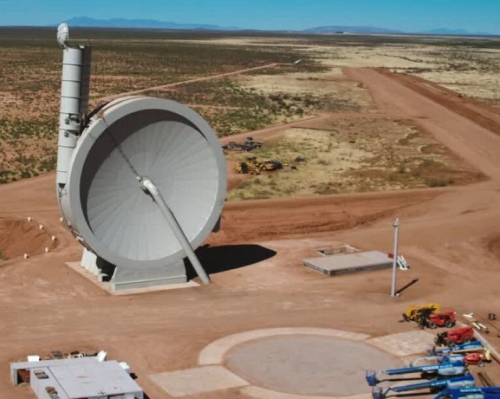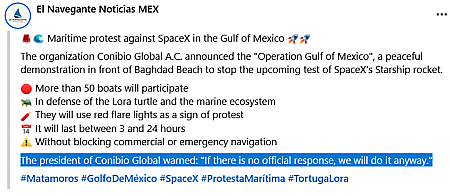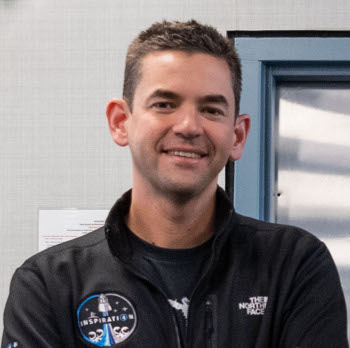Tag: commercial
Jools Holland & Doctor John – Boogie Woogie Twins
Kiss – Black Diamond
An evening pause: Performed live on television 1975. Above these guys are musical showmen.
Hat tip Wamphyr.
Qatar Philharmonic Orchestra -Peter Gunn TV show theme
An evening pause: Performed live c2016. The Peter Gunn showed aired in the late 1950s.
Hat tip Don Carrera.
Saturday Night Live – Washington’s Dream
SpaceX gets major tax credit for the jobs its new Starship factory will create.
Because SpaceX’s new Starship factory, dubbed Gigabay, will create more than 500 new jobs in the Boca Chica region, the Starbase city commission this week awarded the company a sales tax refund valued as much as $3.75 million.
Gigabay will create about 630 new jobs, according to information Barrera showed the City Commission. That number included 315 entry-level jobs, which pay nearly $50,000 a year; 277 staff jobs, which pay nearly $90,000 a year; and 26 manager positions, which pay about $164,000 a year. … At least 25% of the jobs must be filled by veterans, residents of the enterprise zone or people who are considered economically disadvantaged.
SpaceX may receive a sales tax refund of $7,500 per job if the company invests $250 million. The program is capped at 500 jobs, allowing SpaceX to receive a maximum of $3,750,000.
Once again, the opposition to SpaceX does not come from the general public, which overwhelming supports what the company is doing in south Texas because of the wealth it is bringing to the region. The only opposition comes from fringe and very tiny leftist activist groups who oppose anything new, and specifically hate Elon Musk because he backed Donald Trump in last year’s election.
Sadly, those fringe groups are also backed by the propaganda press, which gives them a loud bullhorn they don’t deserve. It is imperative that Texas politicians recognize these facts, and not let that bullhorn bully them into actions detrimental to their constituents.
Because SpaceX’s new Starship factory, dubbed Gigabay, will create more than 500 new jobs in the Boca Chica region, the Starbase city commission this week awarded the company a sales tax refund valued as much as $3.75 million.
Gigabay will create about 630 new jobs, according to information Barrera showed the City Commission. That number included 315 entry-level jobs, which pay nearly $50,000 a year; 277 staff jobs, which pay nearly $90,000 a year; and 26 manager positions, which pay about $164,000 a year. … At least 25% of the jobs must be filled by veterans, residents of the enterprise zone or people who are considered economically disadvantaged.
SpaceX may receive a sales tax refund of $7,500 per job if the company invests $250 million. The program is capped at 500 jobs, allowing SpaceX to receive a maximum of $3,750,000.
Once again, the opposition to SpaceX does not come from the general public, which overwhelming supports what the company is doing in south Texas because of the wealth it is bringing to the region. The only opposition comes from fringe and very tiny leftist activist groups who oppose anything new, and specifically hate Elon Musk because he backed Donald Trump in last year’s election.
Sadly, those fringe groups are also backed by the propaganda press, which gives them a loud bullhorn they don’t deserve. It is imperative that Texas politicians recognize these facts, and not let that bullhorn bully them into actions detrimental to their constituents.
Texas brewery tries brewing beer and growing barley on ISS
A Texas brewery dubbed Starbase Brewing (no connection to SpaceX) has just completed an experiment on ISS where it tried to brew beer in weightlessness as well as grow barley in simulated Martian soil.
Starbase Brewing — unrelated to Elon Musk’s space company or its South Texas city of Starbase — sent its MicroBrew-1 and OASIS experiments to the International Space Station aboard a SpaceX mission Aug. 1. They came back aboard a SpaceX Dragon spacecraft that splashed down eight days later off the coast of California.
…OASIS, short for “Optimizing Agriculture in Simulated Interplanetary Soils,” is the result of a partnership between the beer maker, Texas A&M AgriLife and Jaguar Space, a Colorado bioastronautics firm. According to Argroves, who launched the company in 2020, the goal was to grow barley in a mixture of Martian soil simulant with a byproduct of beermaking called Brewer’s Spent Grain and microbes.
The MicroBrew-1 experiment attempted to ferment beer, mixing “eight containers loaded with half wort — the sugary liquid extracted from malted grains — and half yeast.”
The company is far from manufacturing space-grown beer, but its founder seems focused on being the first brewery selling beer on Mars.
A Texas brewery dubbed Starbase Brewing (no connection to SpaceX) has just completed an experiment on ISS where it tried to brew beer in weightlessness as well as grow barley in simulated Martian soil.
Starbase Brewing — unrelated to Elon Musk’s space company or its South Texas city of Starbase — sent its MicroBrew-1 and OASIS experiments to the International Space Station aboard a SpaceX mission Aug. 1. They came back aboard a SpaceX Dragon spacecraft that splashed down eight days later off the coast of California.
…OASIS, short for “Optimizing Agriculture in Simulated Interplanetary Soils,” is the result of a partnership between the beer maker, Texas A&M AgriLife and Jaguar Space, a Colorado bioastronautics firm. According to Argroves, who launched the company in 2020, the goal was to grow barley in a mixture of Martian soil simulant with a byproduct of beermaking called Brewer’s Spent Grain and microbes.
The MicroBrew-1 experiment attempted to ferment beer, mixing “eight containers loaded with half wort — the sugary liquid extracted from malted grains — and half yeast.”
The company is far from manufacturing space-grown beer, but its founder seems focused on being the first brewery selling beer on Mars.
SpaceX launches 24 more Starlink satellites
SpaceX today successfully launched another 24 Starlink satellites, its Falcon 9 rocket lifting off from Vandenberg in California.
The first stage completed its seventeenth flight, landing on a drone ship in the Pacific.
The leaders in the 2025 launch race:
103 SpaceX
47 China
11 Rocket Lab
11 Russia
SpaceX now leads the rest of the world in successful launches, 103 to 82.
SpaceX today successfully launched another 24 Starlink satellites, its Falcon 9 rocket lifting off from Vandenberg in California.
The first stage completed its seventeenth flight, landing on a drone ship in the Pacific.
The leaders in the 2025 launch race:
103 SpaceX
47 China
11 Rocket Lab
11 Russia
SpaceX now leads the rest of the world in successful launches, 103 to 82.
Study: Car design has worsened, increasing blindspots which cause accidents

The view out of a modern car
Our present dark age: According to a study by the Insurance Institute for Highway Safety (IIHS), in the past two decades the design of cars has drastically decreased the visibility for drivers so that blindspots are larger, resulting in an increase in accidents.
Puzzled by traffic accident data showing that fatalities for cyclists and pedestrians had risen over the past 25 years, while car passenger deaths had come down, IIHS researchers wondered whether drivers might be finding it harder to see those more vulnerable road users.
And they discovered that successive versions of long-running popular cars had obstructed, more and more, a driver’s view of the 10 meters (33 ft) of space they were about to drive into. That near-car view, from the eye point of the average male driver, had shrunk on every one of six long-running models tested, IIHS testing showed, when an early (1997-plus) version was compared with the version on sale in 2023.
In the case of traditional cars, the near-car viewable area had contracted only slightly, the 7-8% reductions from the Honda Accord and Toyota Camry possibly even attributable to measurement error.
When it came to SUVs, however, the shrinkage was dramatic. The driver of a 1997 Honda CR-V could see 68% of a forward half-circle whose perimeter was 10 meters (33 ft) from their eye point – slightly more, in fact, than from the sedans that were tested. The driver of a 2023 CR-V could see just 28% of that semi-circle. In relative terms, the driver of the 2023 CR-V could see only 42% of what they would see from a 1997 model.
You can read the IIHS study here.
Why are designers doing this? One theory is that they are increasingly relying on cameras and software to replace the driver’s sight, and thus feel free to add obstructions to the car body that make it look cool. The problem is that these mechanical non-human solutions simply don’t work as well as the human brain, and thus drivers are hitting things more often.
But don’t worry. Soon AI will soon make it possible for cars will drive themselves! We will even be able to eliminate the windows entirely so that car travel will be an utterly private thing!

The view out of a modern car
Our present dark age: According to a study by the Insurance Institute for Highway Safety (IIHS), in the past two decades the design of cars has drastically decreased the visibility for drivers so that blindspots are larger, resulting in an increase in accidents.
Puzzled by traffic accident data showing that fatalities for cyclists and pedestrians had risen over the past 25 years, while car passenger deaths had come down, IIHS researchers wondered whether drivers might be finding it harder to see those more vulnerable road users.
And they discovered that successive versions of long-running popular cars had obstructed, more and more, a driver’s view of the 10 meters (33 ft) of space they were about to drive into. That near-car view, from the eye point of the average male driver, had shrunk on every one of six long-running models tested, IIHS testing showed, when an early (1997-plus) version was compared with the version on sale in 2023.
In the case of traditional cars, the near-car viewable area had contracted only slightly, the 7-8% reductions from the Honda Accord and Toyota Camry possibly even attributable to measurement error.
When it came to SUVs, however, the shrinkage was dramatic. The driver of a 1997 Honda CR-V could see 68% of a forward half-circle whose perimeter was 10 meters (33 ft) from their eye point – slightly more, in fact, than from the sedans that were tested. The driver of a 2023 CR-V could see just 28% of that semi-circle. In relative terms, the driver of the 2023 CR-V could see only 42% of what they would see from a 1997 model.
You can read the IIHS study here.
Why are designers doing this? One theory is that they are increasingly relying on cameras and software to replace the driver’s sight, and thus feel free to add obstructions to the car body that make it look cool. The problem is that these mechanical non-human solutions simply don’t work as well as the human brain, and thus drivers are hitting things more often.
But don’t worry. Soon AI will soon make it possible for cars will drive themselves! We will even be able to eliminate the windows entirely so that car travel will be an utterly private thing!
SpaceX launches X-37B for Space Force
SpaceX tonight successfully launched the Space Force’s X-37B mini-shuttle, its Falcon 9 rocket lifting off from the Kennedy Space Center in Florida.
This is the eighth mission for the Space Force’s two X-37Bs. It appears this flight is fourth for this particular X-37B, but this is not confirmed. Nor do we know how long this particular will last in orbit.
SpaceX’s first stage completed its sixth flight, landing back at Cape Canaveral. The fairing halves completed their first and second flights respectively.
The leaders in the 2025 launch race:
102 SpaceX
47 China
11 Rocket Lab
11 Russia
SpaceX now leads the rest of the world in successful launches, 102 to 82.
SpaceX tonight successfully launched the Space Force’s X-37B mini-shuttle, its Falcon 9 rocket lifting off from the Kennedy Space Center in Florida.
This is the eighth mission for the Space Force’s two X-37Bs. It appears this flight is fourth for this particular X-37B, but this is not confirmed. Nor do we know how long this particular will last in orbit.
SpaceX’s first stage completed its sixth flight, landing back at Cape Canaveral. The fairing halves completed their first and second flights respectively.
The leaders in the 2025 launch race:
102 SpaceX
47 China
11 Rocket Lab
11 Russia
SpaceX now leads the rest of the world in successful launches, 102 to 82.
The Platters – Smoke Gets In Your Eyes
Avio gets 10-year lease from France to launch its Vega-C from French Guiana
The Italian rocket company Avio has now signed a 10-year lease with France to continue to launch its Vega-C from that nation’s French Guiana spaceport.
In a press release published on 19 August, the French Ministry of the Economy, Finance, and Industrial and Digital Sovereignty confirmed that, in line with the Seville agreement, Avio had been granted a ten-year licence.
…Avio will make use of the ELV launch complex at the Guiana Space Centre for the launch of its Vega C rockets. The pad was previously used for the original Vega rocket, which was officially retired in September 2024.
This deal is part of Europe’s move away from its centralized government-run Arianespace operations to the capitalism model. It has already shifted control of French Guiana from Arianespace back to France’s space agency CNES, which has begun to sign multiple similar deals with other European rocket startups. It is now in the process of shifting control of the Vega-C from Arianespace back to its builder, Avio, a shift that should be completed by the end of this year.
At that time, Avio will market the rocket commercially worldwide. Arianespace will no longer be a government middleman. This launchpad deal solidifies its access to a launch site, which it also plans to use for its next Vega upgrade, the Vega-E.
The Italian rocket company Avio has now signed a 10-year lease with France to continue to launch its Vega-C from that nation’s French Guiana spaceport.
In a press release published on 19 August, the French Ministry of the Economy, Finance, and Industrial and Digital Sovereignty confirmed that, in line with the Seville agreement, Avio had been granted a ten-year licence.
…Avio will make use of the ELV launch complex at the Guiana Space Centre for the launch of its Vega C rockets. The pad was previously used for the original Vega rocket, which was officially retired in September 2024.
This deal is part of Europe’s move away from its centralized government-run Arianespace operations to the capitalism model. It has already shifted control of French Guiana from Arianespace back to France’s space agency CNES, which has begun to sign multiple similar deals with other European rocket startups. It is now in the process of shifting control of the Vega-C from Arianespace back to its builder, Avio, a shift that should be completed by the end of this year.
At that time, Avio will market the rocket commercially worldwide. Arianespace will no longer be a government middleman. This launchpad deal solidifies its access to a launch site, which it also plans to use for its next Vega upgrade, the Vega-E.
Firefly studying feasibility of launching from northern Japanese spaceport

Japan’s spaceports indicated by red dots.
Firefly and the commercial Japanese Hokkaido spaceport in the north of Japan have begun a feasibility study for launching Firefly’s Alpha rocket there.
Establishing an memorandum of understanding with the Hokkaido Spaceport means that the two entities can flesh out a more concrete launch complex design and figure out all of the logistics to bring Alpha launch capabilities to Japan.
In the past Hokkaido has been the location for a number of suborbital launches, but no orbital launches as yet. For example, the Japanese startup Interstellar used this site for its suborbital test flights in 2018, and hopes to use it for future orbital flights.
Firefly meanwhile has launched its Alpha rocket multiple times from Vandenberg in California. The company is also building a launchpad at Wallops Island in Virginia, and has signed a deal with the Esrange spaceport in Sweden. The Swedish launch site however is questionable because any orbital launch from there would have to cross over land of other countries, and so far it appears permission for such a thing has not been arranged. Firefly might therefore be looking at Hookaiddo for precisely this reason.

Japan’s spaceports indicated by red dots.
Firefly and the commercial Japanese Hokkaido spaceport in the north of Japan have begun a feasibility study for launching Firefly’s Alpha rocket there.
Establishing an memorandum of understanding with the Hokkaido Spaceport means that the two entities can flesh out a more concrete launch complex design and figure out all of the logistics to bring Alpha launch capabilities to Japan.
In the past Hokkaido has been the location for a number of suborbital launches, but no orbital launches as yet. For example, the Japanese startup Interstellar used this site for its suborbital test flights in 2018, and hopes to use it for future orbital flights.
Firefly meanwhile has launched its Alpha rocket multiple times from Vandenberg in California. The company is also building a launchpad at Wallops Island in Virginia, and has signed a deal with the Esrange spaceport in Sweden. The Swedish launch site however is questionable because any orbital launch from there would have to cross over land of other countries, and so far it appears permission for such a thing has not been arranged. Firefly might therefore be looking at Hookaiddo for precisely this reason.
Kalandra – Borders
Spinlaunch raises $30 million for its Meridian broadband satellite constellation

The Spinlaunch prototype launcher
Spinlaunch, the startup that began by proposing launching payloads into space using a giant vertically oriented spinning centrifuge (as shown to the right), has now raised $30 million in private investment capital for its proposed Meridian broadband satellite constellation, designed to compete directly with Starlink and Kuiper.
The funding includes new investment from existing investors, including lead investor ATW Partners, as well as the previously announced strategic investment from Kongsberg Defence & Aerospace.
Kongsberg had previously invested $12 million, and is building 280 micro-satellites for this constellation.
It is very unclear from the press release when Spinlaunch will launch its first satellite, though it claims its “first customer link” will take place in second half of 2026. Considering the level of blarney the company exhibited in its initial spin-launch concept, we should remain very skeptical about its satellite constellation claims. Though the company has signed a deal to build a full scale spin launcher in Alaska, it increasingly appears it is shifting its effort from that to satellites.

The Spinlaunch prototype launcher
Spinlaunch, the startup that began by proposing launching payloads into space using a giant vertically oriented spinning centrifuge (as shown to the right), has now raised $30 million in private investment capital for its proposed Meridian broadband satellite constellation, designed to compete directly with Starlink and Kuiper.
The funding includes new investment from existing investors, including lead investor ATW Partners, as well as the previously announced strategic investment from Kongsberg Defence & Aerospace.
Kongsberg had previously invested $12 million, and is building 280 micro-satellites for this constellation.
It is very unclear from the press release when Spinlaunch will launch its first satellite, though it claims its “first customer link” will take place in second half of 2026. Considering the level of blarney the company exhibited in its initial spin-launch concept, we should remain very skeptical about its satellite constellation claims. Though the company has signed a deal to build a full scale spin launcher in Alaska, it increasingly appears it is shifting its effort from that to satellites.
Court rules in favor of SpaceX’s lawsuit against the NLRB’s legal status

Now standing on feet of clay.
The Fifth Circuit of the US. Court of Appeals ruled yesterday that the National Labor Relations Board’s (NLRB) unfair labor practice cases against SpaceX and two other companies should remain suspended until the legal challenges by those companies to the NLRB’s legal authority is settled.
The US Court of Appeals for the Fifth Circuit said Tuesday that being subjected to an unconstitutional administrative proceeding was an irreparable harm that justified preliminary injunctions halting NLRB cases. “The Employers have made their case and should not have to choose between compliance and constitutionality,” Judge Don Willett, a Trump appointee, wrote for the court. “When an agency’s structure violates the separation of powers, the harm is immediate—and the remedy must be, too.”
You can read the court decision here [pdf].
» Read more

Now standing on feet of clay.
The Fifth Circuit of the US. Court of Appeals ruled yesterday that the National Labor Relations Board’s (NLRB) unfair labor practice cases against SpaceX and two other companies should remain suspended until the legal challenges by those companies to the NLRB’s legal authority is settled.
The US Court of Appeals for the Fifth Circuit said Tuesday that being subjected to an unconstitutional administrative proceeding was an irreparable harm that justified preliminary injunctions halting NLRB cases. “The Employers have made their case and should not have to choose between compliance and constitutionality,” Judge Don Willett, a Trump appointee, wrote for the court. “When an agency’s structure violates the separation of powers, the harm is immediate—and the remedy must be, too.”
You can read the court decision here [pdf].
» Read more
Starmer government consolidates the UK Space Agency into larger agency

Soon to be gone, and likely forgotten
The Starmer Labor government in the United Kingdom today announced that it is stripping the UK Space Agency of its independent status and absorbing it into a larger agency, the Department for Science, Innovation and Technology,
Taking place by April 2026, the new unit will keep the UK Space Agency (UKSA) name and brand and will be staffed by experts from both organisations. This will drive up efficiency in line with the government’s Plan for Change, cutting red tape and making Whitehall more agile.
Today also sees the publication of over 60 recommendations from industry leaders on how to improve regulation for space missions, including Rendezvous and Proximity Operations (RPO) – where spacecraft work together in orbit.
The press release is filled with similar language extolling this bureaucratic change as guaranteeing a reduction of the red tape that has squelched the space industry in the United Kingdom, but a close review should make us all highly skeptical. The link for those “60 recommendations” lists nothing of a kind. Instead, it provides a second link to a report describing a government simulation of a licensing process for a commercial rendezvous and proximity satellite mission (RPO) (working with three different commercial companies) which is filled with bureaucratic language that is practically incomprehensible. For example, from the executive summary:
» Read more

Soon to be gone, and likely forgotten
The Starmer Labor government in the United Kingdom today announced that it is stripping the UK Space Agency of its independent status and absorbing it into a larger agency, the Department for Science, Innovation and Technology,
Taking place by April 2026, the new unit will keep the UK Space Agency (UKSA) name and brand and will be staffed by experts from both organisations. This will drive up efficiency in line with the government’s Plan for Change, cutting red tape and making Whitehall more agile.
Today also sees the publication of over 60 recommendations from industry leaders on how to improve regulation for space missions, including Rendezvous and Proximity Operations (RPO) – where spacecraft work together in orbit.
The press release is filled with similar language extolling this bureaucratic change as guaranteeing a reduction of the red tape that has squelched the space industry in the United Kingdom, but a close review should make us all highly skeptical. The link for those “60 recommendations” lists nothing of a kind. Instead, it provides a second link to a report describing a government simulation of a licensing process for a commercial rendezvous and proximity satellite mission (RPO) (working with three different commercial companies) which is filled with bureaucratic language that is practically incomprehensible. For example, from the executive summary:
» Read more
Chet Atkins & Mark Knopfler – I’ll see you in my dreams/Walk of Life
An evening pause: Performed live c2019. I have started the embed after introductions. If you want to see it all, click to begin at the beginning.
Hat tip Doug Johnson.
An evening pause: Performed live c2019. I have started the embed after introductions. If you want to see it all, click to begin at the beginning.
Hat tip Doug Johnson.
Student suborbital rocket fails in first student attempt to reach space
The first rocket launch from Quebec and the first attempt by a student-built rocket to reach suborbital space unfortunately failed soon after lift-off on August 15, 2025 when the second stage separated prematurely.
The launch was part of a program by the rocketry division of a Canadian educational organization, Space Concordia.
While the launch appeared to start smoothly, it was approximately 23 seconds into the launch that the team reported that “vehicle split apart into 2 pieces.” Space Concordia said “the nosecone (came) tumbling to the ground” and that the airframe coasted “briefly before following suit.”
After the launch, and during the webcast, a representative said the “second stage separated early” and mentioned MaxQ, which is when the rocket will be under maximum aerodynamic pressure. Space Concordia said in a press release, “The team is continuing to review data to find the root cause of the anomaly.”
This student rocketry division has had some success over the years with smaller rockets, winning first prize in 2018 in the Intercollegiate Rocket Engineering Competition. This failure simply means it must try again. Either way, it appears it is training a new cadre of Canadian rocket engineers.
Note too that a similar student educational organization in Great Britain, Surrey Space, eventually upgraded its student-built cubesats into a profitable and very successful commercial cubesat manufacturing operation. It is very possible Space Concordia could do the same in Canada with rockets.
The first rocket launch from Quebec and the first attempt by a student-built rocket to reach suborbital space unfortunately failed soon after lift-off on August 15, 2025 when the second stage separated prematurely.
The launch was part of a program by the rocketry division of a Canadian educational organization, Space Concordia.
While the launch appeared to start smoothly, it was approximately 23 seconds into the launch that the team reported that “vehicle split apart into 2 pieces.” Space Concordia said “the nosecone (came) tumbling to the ground” and that the airframe coasted “briefly before following suit.”
After the launch, and during the webcast, a representative said the “second stage separated early” and mentioned MaxQ, which is when the rocket will be under maximum aerodynamic pressure. Space Concordia said in a press release, “The team is continuing to review data to find the root cause of the anomaly.”
This student rocketry division has had some success over the years with smaller rockets, winning first prize in 2018 in the Intercollegiate Rocket Engineering Competition. This failure simply means it must try again. Either way, it appears it is training a new cadre of Canadian rocket engineers.
Note too that a similar student educational organization in Great Britain, Surrey Space, eventually upgraded its student-built cubesats into a profitable and very successful commercial cubesat manufacturing operation. It is very possible Space Concordia could do the same in Canada with rockets.
Proposed Australian commercial spaceport signs land lease

Proposed Australian spaceports.
Click for original image.
After being forced to change locations because of red tape and the refusal of the local aborigine authorities to sign an agreement, the Australian commercial spaceport startup Space Centre Australia has now obtained a land lease for its new location, dubbed Atakani, on the eastern shore of Cape York.
Space Centre Australia Pty Ltd (SCA) has secured a spaceport land lease, signing a multi-decade agreement with the local Traditional Landowners for approximately 300 km² at Billy’s Lagoon, Cape York. The agreement paves the way for the development of the Atakani Space Centre (ASC).
The Binding Term Sheet, signed with the support of Mokwiri RNTBC, marks the first time an Australian-based spaceport has secured a lease and opportunity of this scale. It ensures Traditional Owner access to country for cultural and ceremonial purposes, governance participation through the soon-to-be-established Luthiggi Corporation, and direct involvement in environmental management, cultural heritage monitoring, and operational activities. A royalty framework will deliver long-term economic benefits in addition to the spaceport’s operational revenue.
At the moment it appears the spaceport’s focus will be attracting suborbital launch companies, with the eventual goal to bring orbital rockets to the site.

Proposed Australian spaceports.
Click for original image.
After being forced to change locations because of red tape and the refusal of the local aborigine authorities to sign an agreement, the Australian commercial spaceport startup Space Centre Australia has now obtained a land lease for its new location, dubbed Atakani, on the eastern shore of Cape York.
Space Centre Australia Pty Ltd (SCA) has secured a spaceport land lease, signing a multi-decade agreement with the local Traditional Landowners for approximately 300 km² at Billy’s Lagoon, Cape York. The agreement paves the way for the development of the Atakani Space Centre (ASC).
The Binding Term Sheet, signed with the support of Mokwiri RNTBC, marks the first time an Australian-based spaceport has secured a lease and opportunity of this scale. It ensures Traditional Owner access to country for cultural and ceremonial purposes, governance participation through the soon-to-be-established Luthiggi Corporation, and direct involvement in environmental management, cultural heritage monitoring, and operational activities. A royalty framework will deliver long-term economic benefits in addition to the spaceport’s operational revenue.
At the moment it appears the spaceport’s focus will be attracting suborbital launch companies, with the eventual goal to bring orbital rockets to the site.
The Yardbirds – Shapes of Things
An evening pause: Performed on French television in 1966. I suspect they are lip-synching to the record album, but the editing makes this hard to confirm.
Hat tip Diane Zimmerman.
Oh by the way, the FAA has approved the August 24th launch of Starship/Superheavy

Increasingly irrelevant in the right places
My headline reflects the sense of utter irrelevance of the FAA in announcing its approval of the launch licence for the tenth test launch of Starship/Superheavy (now scheduled for August 24, 2025) as well as its “closing” of its “investigation” into the failure during test flight nine.
As per the FAA in its statement, “There are no reports of public injury or damage to public property. The FAA oversaw and accepted the findings of the SpaceX-led investigation. The final mishap report cites the probable root cause for the loss of the Starship vehicle as a failure of a fuel component. SpaceX identified corrective actions to prevent a reoccurrence of the event.”
The FAA did not “oversee” SpaceX’s investigation. No one at the FAA has the slightest qualifications for doing so. All its bureaucrats did is sit in and watch, and when SpaceX’s engineers completed their work and “identified corrective actions,” the FAA paper-pushers pushed some paper to rubber stamp those conclusions.
Moreover, unlike during the Biden administration, the FAA did not waste any time or money retyping the SpaceX investigation. They simply approved it as is, and issued the launch license. And they apparently instantly agreed to the schedule proposed by SpaceX. In fact, it appears almost as if SpaceX announced the date before the FAA announced the license approval.
Elections matter. And they would matter less if we had had the sense in the past century to not cede so much power to an unelected federal bureaucracy that is really unfit to do the work we gave them. The goal now should be to take that power away from them, and to do it as quickly as it is humanely possible.
It appears at least when it comes to FAA launch licenses, Trump has made some significant progress towards this goal.

Increasingly irrelevant in the right places
My headline reflects the sense of utter irrelevance of the FAA in announcing its approval of the launch licence for the tenth test launch of Starship/Superheavy (now scheduled for August 24, 2025) as well as its “closing” of its “investigation” into the failure during test flight nine.
As per the FAA in its statement, “There are no reports of public injury or damage to public property. The FAA oversaw and accepted the findings of the SpaceX-led investigation. The final mishap report cites the probable root cause for the loss of the Starship vehicle as a failure of a fuel component. SpaceX identified corrective actions to prevent a reoccurrence of the event.”
The FAA did not “oversee” SpaceX’s investigation. No one at the FAA has the slightest qualifications for doing so. All its bureaucrats did is sit in and watch, and when SpaceX’s engineers completed their work and “identified corrective actions,” the FAA paper-pushers pushed some paper to rubber stamp those conclusions.
Moreover, unlike during the Biden administration, the FAA did not waste any time or money retyping the SpaceX investigation. They simply approved it as is, and issued the launch license. And they apparently instantly agreed to the schedule proposed by SpaceX. In fact, it appears almost as if SpaceX announced the date before the FAA announced the license approval.
Elections matter. And they would matter less if we had had the sense in the past century to not cede so much power to an unelected federal bureaucracy that is really unfit to do the work we gave them. The goal now should be to take that power away from them, and to do it as quickly as it is humanely possible.
It appears at least when it comes to FAA launch licenses, Trump has made some significant progress towards this goal.
SpaceX launches 24 more Starlink satellites
SpaceX today successfully placed another 24 Starlink satellites into orbit, its Falcon 9 rocket lifting off from Vanenberg in California.
The first stage completed its ninth flight, landing on a drone ship in the Pacific.
The leaders in the 2025 launch race:
101 SpaceX
46 China
11 Rocket Lab
9 Russia
SpaceX now leads the rest of the world in successful launches, 101 to 79.
SpaceX today successfully placed another 24 Starlink satellites into orbit, its Falcon 9 rocket lifting off from Vanenberg in California.
The first stage completed its ninth flight, landing on a drone ship in the Pacific.
The leaders in the 2025 launch race:
101 SpaceX
46 China
11 Rocket Lab
9 Russia
SpaceX now leads the rest of the world in successful launches, 101 to 79.
Japanese rocket startup Interstellar signs five customers for first orbital launch
The Japanese rocket startup Interstellar, which is being backed largely by Toyota, has announced that it has gotten five customer payloads for the first orbital launch of its Zero rocket.
This milestone mission will include cubesats from four organizations, Ocullospace, Wolfpack, Osaka Metropolitan University and Tokyo City University, and a fifth participant, DALRO Aerospace, that will supply the separation system for the universities’ cubesats. These 5 customers have already signed each a Launch Service Agreement with Interstellar. This launch highlights Interstellar’s growing global partnerships and commitment to expanding access to orbit.
These payloads are typical for a first launch. Three of these payloads are for educational institutions, while the remaining two are smallsat startups that have not launched yet, with one supported by the South Korean government. None have much money, so are willing to take the risk of a first launch.
As for when that first launch will take place, this is unclear. The company had previously targeted a launch in 2025, but based on the present status, this seems highly unlikely. The company itself was largely inactive from 2018 (when it did some suborbital test launches) until this year (when both Toyota and the Japanese government stepped in to provide financing). Expect it therefore to take time to get back into operation.
The Japanese rocket startup Interstellar, which is being backed largely by Toyota, has announced that it has gotten five customer payloads for the first orbital launch of its Zero rocket.
This milestone mission will include cubesats from four organizations, Ocullospace, Wolfpack, Osaka Metropolitan University and Tokyo City University, and a fifth participant, DALRO Aerospace, that will supply the separation system for the universities’ cubesats. These 5 customers have already signed each a Launch Service Agreement with Interstellar. This launch highlights Interstellar’s growing global partnerships and commitment to expanding access to orbit.
These payloads are typical for a first launch. Three of these payloads are for educational institutions, while the remaining two are smallsat startups that have not launched yet, with one supported by the South Korean government. None have much money, so are willing to take the risk of a first launch.
As for when that first launch will take place, this is unclear. The company had previously targeted a launch in 2025, but based on the present status, this seems highly unlikely. The company itself was largely inactive from 2018 (when it did some suborbital test launches) until this year (when both Toyota and the Japanese government stepped in to provide financing). Expect it therefore to take time to get back into operation.
China completes two launches today
China today completed two launches using two different rockets from two different spaceports.
First, its Long March 4C rocket lifted off from its Xichang spaceport in southwest China, placing what its state-run press described as a satellite designed to do “space environment exploration and related technology tests,” No other information was released.
Next, its Long March 6A rocket lifted off from its Taiyuan spaceport in north China, placing the ninth set of Guowang satellites into orbit for a planned 13,000 constellation designed to compete with Starlink and Kuiper. This launch placed five satellites into orbit, bringing the total launched so far to 72.
In both cases, no word was released on where the rockets’ lower stages crashed inside China. This is especially significant for the Long March 4C rocket, which uses very toxic hypergolic fuels and lifted off from a spaceport much more inland than the Long March 6A.
The leaders in the 2025 launch race:
100 SpaceX
46 China
11 Rocket Lab
9 Russia
SpaceX now leads the rest of the world in successful launches, 100 to 79.
China today completed two launches using two different rockets from two different spaceports.
First, its Long March 4C rocket lifted off from its Xichang spaceport in southwest China, placing what its state-run press described as a satellite designed to do “space environment exploration and related technology tests,” No other information was released.
Next, its Long March 6A rocket lifted off from its Taiyuan spaceport in north China, placing the ninth set of Guowang satellites into orbit for a planned 13,000 constellation designed to compete with Starlink and Kuiper. This launch placed five satellites into orbit, bringing the total launched so far to 72.
In both cases, no word was released on where the rockets’ lower stages crashed inside China. This is especially significant for the Long March 4C rocket, which uses very toxic hypergolic fuels and lifted off from a spaceport much more inland than the Long March 6A.
The leaders in the 2025 launch race:
100 SpaceX
46 China
11 Rocket Lab
9 Russia
SpaceX now leads the rest of the world in successful launches, 100 to 79.
A protest of boats now intends to violate the range and prevent the next Starship/Superheavy test launch

Protest announcement. Click for original.
A Mexico activist group now plans to launch a fleet of boats that plan to violate the range and prevent the next Starship/Superheavy test launch.
A translated version of the protest announcement can be seen to the right. From the first link above:
A Mexican environmental group, Comité Global A.C., said it plans to protest the launch by sending boats into the Gulf of Mexico near Starbase. If they enter designated safety areas during the planned launch period, they could delay the mission.
The group’s leader said the Matamoros Port Authority gave permission for the protest dubbed “Operación Golfo de México.” It will also include protesters on Playa Bagdad, a Mexican beach just south of the Rio Grande where people often gather for Starship launches.
I have not yet gotten confirmation that the local port authority has approved this protest as the organization claims, but it also appears that this activist group intends to show up in boats regardless. If so, this protest could easily cause the next test launch, now scheduled for August 24, 2025, to be delayed endlessly.
It seems this is a matter for Trump and the Coast Guard. Someone must move in and remove these boats, arresting and fining the occupants for violating launch range restrictions that apply to all international waters.
Hat tip to reader Richard M.

Protest announcement. Click for original.
A Mexico activist group now plans to launch a fleet of boats that plan to violate the range and prevent the next Starship/Superheavy test launch.
A translated version of the protest announcement can be seen to the right. From the first link above:
A Mexican environmental group, Comité Global A.C., said it plans to protest the launch by sending boats into the Gulf of Mexico near Starbase. If they enter designated safety areas during the planned launch period, they could delay the mission.
The group’s leader said the Matamoros Port Authority gave permission for the protest dubbed “Operación Golfo de México.” It will also include protesters on Playa Bagdad, a Mexican beach just south of the Rio Grande where people often gather for Starship launches.
I have not yet gotten confirmation that the local port authority has approved this protest as the organization claims, but it also appears that this activist group intends to show up in boats regardless. If so, this protest could easily cause the next test launch, now scheduled for August 24, 2025, to be delayed endlessly.
It seems this is a matter for Trump and the Coast Guard. Someone must move in and remove these boats, arresting and fining the occupants for violating launch range restrictions that apply to all international waters.
Hat tip to reader Richard M.
Primal Space – The water system of the ancient city of Granada
Candy Dulfer & Jan Van Duikeren – Jazz improvisation
Jared Isaacman proves in an op-ed today why Trump dumped him

Jared Isaacman has now proven he was
the wrong man for NASA administrator
In an op-ed posted today by Jared Isaacman and Newt Gingrich, the two men pushed the idea that NASA should lead a new “mini-Manhattan Project” to develop “nuclear-electric-powered spaceships” in order to conquer the heavens.
The President’s budget calls for an eventual pivot away from NASA’s Space Launch System (SLS)—leaving the heavy-lift rocket business to a capable commercial industry. That pivot should be toward something no other agency, organization, or company is capable of accomplishing: building a fleet of nuclear-electric-powered spaceships and extending America’s reach in the ultimate high ground of space.
The NASA centers, workforce, and contractors that manage, assemble, and test SLS are suited to take on this inspiring and necessary challenge. NASA Center at Michoud, for example, built landing craft during WWII, the Saturn V during the space race, the Space Shuttle, and the SLS. It is now waiting for the next logical evolution to ensure the competitiveness of our national space capabilities.
Oy. What piffle. » Read more
SpaceX donates $4.4 million to upgrade beach access at Boca Chica
Even as leftist politicians and anti-Musk haters rage incoherently against SpaceX’s growing facility at Boca Chica, the company this week donated $4.4 million to upgrade the beach access and facilities at South Padre Island, near Starbase at Boca Chica.
Beachgoers visiting South Padre Island will soon be able to enjoy a surfside park with a smorgasbord of family-friendly amenities paid for by a $4.4 million contribution from Elon Musk’s SpaceX. Previously, MySA reported that the project was expected to cost $4.5 million, according to Texas Department of Licensing and Regulation records.
Cameron County Beach Access #3, a currently undeveloped pedestrian beach access located just outside the South Padre Island city limits, will soon begin construction on the latest phase of a multimillion-dollar improvement project that will transform it into a destination beach access. To that end, Cameron County leaders celebrated with a groundbreaking ceremony on Monday, August 11, at the access, located at 28495 State Park Road 100-North, on South Padre Island.
In other words, SpaceX is paying almost the entire bill for this work. It might now have the power to close these beaches when necessary, but it is also acting like a good citizen, improving those beaches for everyone when they are open.
It is expected this work will be completed by next year.
Even as leftist politicians and anti-Musk haters rage incoherently against SpaceX’s growing facility at Boca Chica, the company this week donated $4.4 million to upgrade the beach access and facilities at South Padre Island, near Starbase at Boca Chica.
Beachgoers visiting South Padre Island will soon be able to enjoy a surfside park with a smorgasbord of family-friendly amenities paid for by a $4.4 million contribution from Elon Musk’s SpaceX. Previously, MySA reported that the project was expected to cost $4.5 million, according to Texas Department of Licensing and Regulation records.
Cameron County Beach Access #3, a currently undeveloped pedestrian beach access located just outside the South Padre Island city limits, will soon begin construction on the latest phase of a multimillion-dollar improvement project that will transform it into a destination beach access. To that end, Cameron County leaders celebrated with a groundbreaking ceremony on Monday, August 11, at the access, located at 28495 State Park Road 100-North, on South Padre Island.
In other words, SpaceX is paying almost the entire bill for this work. It might now have the power to close these beaches when necessary, but it is also acting like a good citizen, improving those beaches for everyone when they are open.
It is expected this work will be completed by next year.
